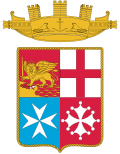 Anteo A 5309 | |
| History | |
|---|---|
| Name | Anteo |
| Builder | Cantiere Navale Ernesto Breda, Marghera, (Venezia) |
| Laid down | 20 July 1977 |
| Launched | 11 November 1978 |
| Commissioned | 31 July 1980 |
| In service | 1 |
| Homeport | La Spezia |
| Identification |
|
| Motto | In undis per undas pro vita |
| Status | Active |
| General characteristics | |
| Type | submarine rescue ship |
| Displacement | 3,874 tonnes (full-load). [1] |
| Length | 98.4 m (322 ft 10 in) |
| Beam | 15.8 m (51 ft 10 in) |
| Draught | 6.5 m (21 ft 4 in) |
| Propulsion |
|
| Speed | 20 knots (37 km/h; 23 mph) |
| Range | |
| Complement | 141 |
| Sensors & processing systems | 2 x GEM Elettronica navigation radars AN/SPN-748 |
| Armament | 2 × Oerlikon 20/70 mm or Browning M2HB 12,7 mm |
| Notes |
|

Anteo (A 5309) is a submarine rescue ship of the Italian Navy, assigned to Raggruppamento Subacquei ed Incursori "Teseo Tesei" (COMSUBIN). [3] Anteo is the third ship to bear this name in the Italian Navy. The ship's design was developed by the "Ufficio Navi Speciali del Reparto Progetti Navi" (Special Office of the Ships Projects Division), according to the guidelines provided by the Navy General Staff. The ship was built at Cantiere Navale Breda di Porto Marghera and commissioned to the Italian Navy on 31 July 1980.

